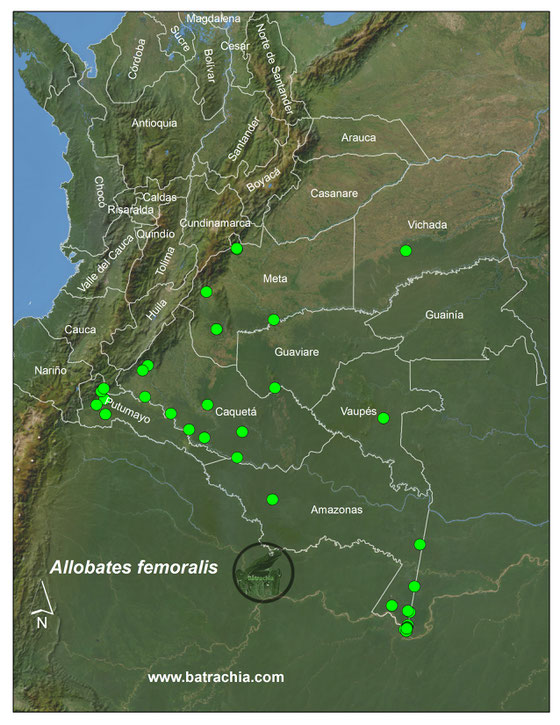Allobates femoralis (Boulenger , 1884)

Distribución en Colombia:
Amplia distribución desde las selvas húmedas tropicales y bosques subandinos de las estribaciones de la vertiente oriental de la cordillera Oriental y Trapecio Amazónico en los Departamentos del Amazonas (Lynch, 2005; Sánchez, 2013), Caquetá (Silverstone, 1976;Ruiz et al. 1996;Acosta, 2000;Osorno et al.2011; Suárez & Lynch, 2017; Acosta Galvis, 2018;Medina-Rangel et al. 2019; Rodríguez et al. 2020), Meta (Cochran & Goin, 1970; Silverstone, 1976; Ruiz et al. 1996; Lynch, 2006;Acosta, 2000;Amezquita et al. 2009) Putumayo (Silverstone, 1976; Ruiz et al. 1996; Acosta, 2000) entre los 80-943 metros de altitud.

Referencias:
Acosta-Galvis, A.R. 2000. Ranas, Salamandras y Caecilias (Tetrapoda: Amphibia) de Colombia. Biota Colombiana1(3):289-319.
Acosta Galvis, A.R. 2018. Anfibios del Escudo Guayanés en Colombia. Pp. 63-102. En: Lasso, C. A. y J. C. Señaris (Eds.), Volumen VI. Fauna Silvestre del Escudo Guayanés (Colombia-Venezuela). Serie Editorial Fauna Silvestre Neotropical. Instituto de Investigación de Recursos Biológicos Alexander von Humboldt. Bogotá, D. C., Colombia
Amezquita, A., Lima, A. P., Jehle, R., Castellanos, L., Ramos, O., Crawford, A. J.,Gasser H. & Hoedl, W. 2009. Calls, colours, shape, and genes: a multi-trait approach to the study of geographic variation in the Amazonian frog Allobates femoralis. Biological Journal of the Linnean Society, 98(4):826-838.
Cochran, D. M. y C. J. Goin. 1970. Frogs of Colombia. Smithsonian Institution Press, USA. 655 pp.
Lynch J.D. 2005. Discovery of the richest frog fauna in the World-an exploration of the forests to the north of Leticia. Revista de la Academia Colombiana de Ciencias Exactas, Físicas y Naturales:29 (113): 581-588
Lynch, J.D. 2006. The amphibian fauna in the Villavicencio region of Eastern Colombia. Caldasia 28(1): 135-155.
Medina-Rangel, G. F., Thompson, M. E. & Ruiz, D. H. 2019. Anfibios y reptiles. En Reyes, D. A., Botero-García, R., del Campo, Á., Kotlinski, N., Lemos, A., Miller, T., Pitman, N., de Souza, L., Stotz, D. F.,Salazar-Molano, A., Samper-Samper, F., Thompson, M. E., Vásquez-Cerón, A., Vriesendorp, C. & Wachter, T. (Eds). Colombia: Bajo Caguán-Caquetá. Pp: 107-116. Chicago: The Field Museum, Rapid Biological and Social Inventories Report 30. 447 pp.
Osorno Muñoz M. , D. L. Gutiérrez-Lamus, & J. C. Blanco. 2011. Anfibios en un gradiente de intervención en el noroccidente de la Amazonia colombiana. Revista Colombia Amazónica (4) :143-160.
Rodríguez, C., Amézquita, A., Ringler, M., Pašukonis, A., & Hödl, W. 2020. Calling amplitude flexibility and acoustic spacing in the territorial frog Allobates femoralis. Behavioral Ecology and Sociobiology, 74(6), 1-10.
Sánchez D.A. 2013 Larval morphology of Dart-Poison Frogs (Anura: Dendrobatoidea: Aromobatidae and Dendrobatidae).Zootaxa 3637 (5): 569–591.
Silverstone, P.A. 1976. A revision of the poison arrow frogs of the genus PhyllobatesBibron in Sagra (Family Dendrobatidae). Natural History Museum of Los Angeles County Science Bulletin: 1-53.
Suárez-Mayorga, A. M., & Lynch, J. D. (2017). Myth and truth on the herpetofauna of Chiribiquete: from the lost world to the last world. Revista Colombia Amazónica, 10, 177-190.
Actualización 8 de marzo de 2015, 30 de noviembre de 2017; 29 de Julio de 2018; 8 de julio 2019; 27 de abril, 2020; 30 de abril, 2020;22 de Agosto, 2020.

 Lista de los Anfibios de Colombia/Checklist Colombian Amphibians
Lista de los Anfibios de Colombia/Checklist Colombian Amphibians



